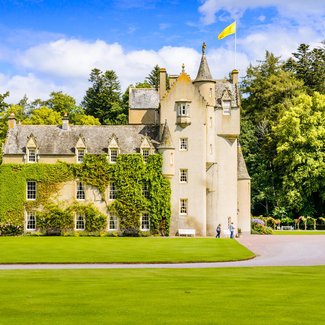Castles are a feature throughout Scotland, and Moray Speyside has a few particularly lovely ones to visit.
Beautiful sandstone Ballindalloch Castle is a jewel in Speyside's crown. In the Macpherson-Grant family since the sixteenth century, it remains a family home with a hint of the fairytale about it. Today, you can tour the castle, visit the gardens, walk in the grounds and visit the tearoom or the new single malt whisky distillery. Even the toilets are award-winning!
Another castle that's well-located to tie in with a whisky distillery visit (or two) is Balvenie Castle, whose ruins stand proudly right next door to Glenfiddich and Balvenie distilleries. This 13th-century curtain-walled castle was built by the earls of Buchan and later transformed into a grand Renaissance residence. These days the only inhabitants of the castle are of the winged variety, but visiting the site gives a good sense of what it must have been like as a stronghold all those centuries ago.
Near the town of Elgin are the ruins of Duffus Castle, a medieval stronghold of the Moray family and a great example of a motte and bailey castle. Originally built of timber, it was replaced with the current stone structure in the fourteenth century. The castle sits on the Laich of Moray, a flat plain originally next to Spynie Loch, which has since been drained.
Brodie Castle is a stunning turreted building close to the town of Forres. Like Ballindalloch, it's a Z-plan castle. Over 100 varieties of daffodil in the grounds form a stunning carpet of yellow in the springtime. As well as visiting the castle itself and admiring the collection of Dutch Old Masters, the gardens are a lovely place for a walk, and there's an excellent play area if you're visiting with children. The aptly-named Playful Garden on the estate is a fun educational experience exploring the castle's history and the surrounding area with a touch of fantasy, sculpture and storytelling thrown in for good measure.
Poised on a cliff-edge by the Moray Firth are the ruins of Findlater Castle. First mentioned in the history books in 1246, today's modest stone structure belies a much grander past. The atmosphere of the site makes it worth a visit, and there's a nice 6-mile walk to the site from the pretty seaside village of Cullen.
Drumin Castle sits close to the confluence of the River Avon and River Livet. Much of the structure is nowhere to be seen these days, but the original tower is still impressive, with commanding views across this naturally strategic location. There is a car park nearby and a choice of walks to visit the ruins. Whilst the current castle dates back to the 15th century, there is strong evidence of earlier occupation, and it appears that there may have been an Iron Age Dun on the site.
Cawdor Castle is (somewhat erroneously) famous as the setting of Shakespeare's Macbeth, but the reality is a little more complex. The original castle dates from the 14th century, but the current structure emerged on a nearby site in the 15th century. As well as exploring the grand rooms inside the castle, there are three beautiful gardens on the site and a lovely collection of woodland nature trails. For fans of other outdoor pursuits, there is also salmon fishing available in the castle grounds and even a 9-hole golf course.



